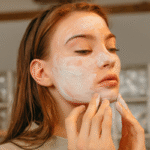When it comes to skincare, most people are looking for natural, affordable, and effective solutions. If you’re on the hunt for glowing, radiant skin, ayurvedic tips for glowing skin could be exactly what you need.
Ayurveda, the ancient system of healing from India, emphasizes the connection between mind, body, and spirit, offering holistic beauty practices that nourish the skin from within.
Whether you’re struggling with dullness, acne, dryness, or signs of aging, Ayurveda provides a wealth of natural remedies that can help restore balance and bring out your skin’s natural glow.
In this blog post, we’ll explore some simple yet effective Ayurvedic tips that can transform your skin, revealing a healthier, more vibrant complexion.
From customizing your skincare routine to incorporating dietary changes and lifestyle habits, you’ll learn how to incorporate Ayurvedic practices into your daily routine to achieve glowing skin in a safe, affordable, and natural way.
Table of Contents
What is Ayurveda and How Can It Enhance Your Skin’s Health?
Before we explore the best Ayurvedic tips for glowing skin, let’s first understand the foundation of Ayurveda and how it works.
Ayurveda is a traditional medicinal system originating from India, with origins exceeding 5,000 years in history. It revolves around the idea of balancing three primary energies, or doshas – Vata, Pitta, and Kapha – that govern various bodily functions.
According to Ayurveda, each individual has a unique balance of these doshas, and maintaining harmony between them is key to overall health, including healthy skin.
For skin care, Ayurveda advocates using natural, plant-based ingredients, oils, and herbs to cleanse, nourish, and rejuvenate the skin.
The emphasis is on targeting the underlying cause of skin problems, rather than merely alleviating the symptoms. By embracing Ayurvedic skincare, you can achieve a glow that’s not only skin-deep but also comes from within.
1. Tailoring Your Skincare Regimen Based on Your Dosha
In Ayurveda, each person has a unique constitutional makeup known as a dosha. The three main doshas are Vata, Pitta, and Kapha, and each one influences your skin’s health and appearance.
Understanding your dosha can help you tailor your skincare routine to suit your skin’s specific needs, ensuring you get the best results.
• Vata (Dry skin): If your skin falls under the Vata category, it tends to be parched, rough, and susceptible to dehydration. Focus on moisturizing and hydrating products. Choose oils and creams that contain nourishing ingredients like sesame oil, almond oil, or ghee to keep your skin soft and supple.
• Pitta (Sensitive skin): Pitta skin tends to be sensitive, prone to redness, irritation, and breakouts. To balance Pitta, use soothing products that calm the skin, such as aloe vera, rose water, and sandalwood. Avoid abrasive exfoliants or items containing potent fragrances.
• Kapha (Oily skin): Those with a Kapha skin type might notice excess oiliness or a tendency toward acne. Use lighter, non-greasy moisturizers and opt for ingredients like neem, turmeric, and tea tree oil that help regulate oil production and fight acne-causing bacteria.
By selecting products and ingredients that align with your dosha, you can ensure that your skincare routine is perfectly suited to your skin’s unique needs.
2. Ayurvedic Facial Massages
Ayurvedic facial massages are a luxurious and effective way to promote glowing skin. These massages not only help to relax your facial muscles but also improve blood circulation, which encourages the flow of oxygen and nutrients to your skin cells.
Additionally, facial massages can help detoxify your skin by promoting lymphatic drainage and reducing puffiness.
One of the most popular techniques in Ayurveda is the use of Abhyanga, or self-massage, which involves massaging warm oils into the skin. For your face, you can use oils such as coconut oil, sesame oil, or even a blend of essential oils like lavender and rose.
Gently massage your face in upward circular motions for about 5-10 minutes to boost circulation and promote skin rejuvenation.
3. Ayurvedic Herbal Remedies and Face Masks
Ayurveda has a rich tradition of using herbs to enhance the health and appearance of the skin. Many of these herbs have anti-inflammatory, antioxidant, and anti-aging properties that can work wonders on your complexion.
• Turmeric: Recognized for its potent anti-inflammatory effects, turmeric is a popular ingredient in Ayurvedic skincare routines. You can make a simple face mask by mixing turmeric powder with honey and yogurt to reduce redness, brighten the skin, and prevent breakouts.
• Neem: Neem is commonly utilized in Ayurveda due to its antimicrobial and antifungal characteristics. It’s great for acne-prone skin. You can apply a neem face mask or utilize neem oil to detoxify and purify your skin.
• Sandalwood: Sandalwood is cooling and calming, making it perfect for those with sensitive or inflamed skin. Sandalwood powder mixed with rose water can be used as a face mask to soothe irritation and brighten the skin.
These herbal remedies, when used regularly, can help you achieve smoother, clearer, and glowing skin over time.
4. Ayurvedic Detox
A key component of Ayurveda is detoxification. The idea is to eliminate toxins (ama) from the body to promote overall health and well-being, which in turn benefits your skin.
Ayurvedic detox methods, such as panchakarma, can help cleanse your body of accumulated impurities, leaving your skin looking radiant and fresh.
For a simple DIY detox, consider drinking herbal teas such as triphala or ginger tea, both known for their detoxifying and digestion-boosting properties, as recommended in Ayurvedic tips for glowing skin.
Additionally, incorporating more fiber-rich foods and staying hydrated with water infused with herbs like mint and cucumber can support your body’s natural detox processes and give your skin a healthy, glowing appearance.
5. An Ayurvedic Diet for Healthy Skin
Your skin’s health is deeply connected to what you eat. In Ayurveda, food serves as medicine, and choosing the correct diet, as part of Ayurvedic tips for glowing skin, can harmonize your dosha, enhance digestion, and support glowing skin.
• Vata Diet: For dry skin types, focus on warm, moist, and nourishing foods. Include additional nourishing fats such as ghee, olive oil, and avocados. Suitable options include stews, soups, and steamed vegetables.
• Pitta Diet: To soothe irritated or inflamed skin, steer clear of spicy, acidic, or greasy foods. Recommend refreshing foods such as cucumbers, leafy vegetables, and dairy products like milk and yogurt.
• Kapha Diet: If you have oily or acne-prone skin, focus on light, easily digestible foods that promote detoxification. Incorporate fruits, vegetables, legumes, and spices like turmeric, cumin, and coriander into your meals.
An Ayurvedic regimen focuses on natural, minimally processed foods and promotes consuming in balanced portions. By following the principles of Ayurvedic eating, you can help nourish your skin from the inside out.
6. Ayurvedic Lifestyle Practices
Your lifestyle choices also play a significant role in achieving glowing skin. Ayurvedic tips for glowing skin recommend several practices that can improve your skin’s health by balancing your mind and body.
• Sufficient Rest: Quality sleep is crucial for maintaining healthy skin. Strive for 7-9 hours of peaceful sleep nightly to enable your skin to heal and renew itself.
• Stress Management: Stress can wreak havoc on your skin, leading to breakouts and dullness. Practice stress-reducing activities such as yoga, meditation, or deep-breathing exercises, as part of Ayurvedic tips for glowing skin, to keep your mind calm and your skin glowing.
• Exercise: Regular physical activity increases blood circulation, which helps deliver oxygen and nutrients to your skin. Whether it’s yoga, walking, or another form of exercise, staying active can boost your skin’s appearance.
Exfoliate with Natural Ingredients
Exfoliating your skin regularly is important for removing dead skin cells and revealing a fresh glow, following Ayurvedic tips for glowing skin. Ayurveda recommends natural exfoliants like rice flour, chickpea powder, or ground oats.
These ingredients gently scrub the skin while providing nourishment, which is crucial for maintaining a youthful, glowing complexion, following Ayurvedic tips for glowing skin.
Exfoliation recipe:
• Mix 1 tablespoon of rice flour with water or rose water to form a paste.
• Gently massage it on your face in circular motions, then rinse off with lukewarm water.
• Exfoliate 1-2 times a week to remove dead skin and reveal a fresh glow.
Protect Your Skin with Natural Sunscreens
Exposing your skin to the sun’s harmful UV rays can cause premature aging and dullness.
Ayurveda recommends using natural sunscreens that are rich in antioxidants, such as oils made from carrot seeds or aloe vera, as part of Ayurvedic tips for glowing skin. These oils not only protect your skin from the sun but also nourish and hydrate it.
Natural sunscreens:
• Aloe Vera Gel: Soothes and protects your skin from sunburn.
• Carrot Seed Oil: Rich in beta-carotene, it helps prevent sun damage and premature aging.
• Coconut Oil: Provides natural sun protection and intensely moisturizes the skin.
Ayurveda’s Skin-Boosting Herbs
Herbs play a vital role in Ayurvedic tips for glowing skin. They can be used in various forms, from essential oils to powders, and offer numerous skin benefits.
Neem
Neem is a powerful herb with antibacterial and antifungal properties. It helps purify the blood, reduce acne, and combat skin infections.
• Alternative Method: Mix neem powder with a few drops of rose water or honey to form a smooth paste, then gently spread it over your face as a nourishing mask. Alternatively, neem oil can be used to treat acne-prone areas.
Aloe Vera
Aloe vera is a soothing and cooling herb that hydrates the skin and helps reduce sunburns and pigmentation.
• How to Use: Apply fresh aloe vera gel directly from the plant to your skin to provide instant hydration and a refreshing glow.
Focus on Hydration
Hydrated skin is healthy skin. One of the easiest ways to maintain glowing skin with a minimalist routine, based on Ayurvedic tips for glowing skin, is by focusing on hydration.
Opt for a hydrating toner, serum, and moisturizer to keep your skin plump and dewy. Don’t forget to drink plenty of water throughout the day to maintain hydration from the inside out.
The Importance of Consistency
Consistency is key to achieving glowing skin. Sticking to your routine for several weeks, following Ayurvedic tips for glowing skin, will help your skin adjust and show visible improvements. Give your products time to work, and be patient with your skin.
Avoid Skin Care Overload
The more products you apply, the more chances there are for irritation. Stick to a simple, core set of products based on Ayurvedic tips for glowing skin and avoid skin-care overload.
You don’t need ten different serums to get glowing skin—just a few well-chosen products will do.
Conclusion
Incorporating ayurvedic tips for glowing skin into your daily routine is a wonderful way to achieve healthier, more radiant skin using natural, time-tested practices.
Whether it’s through customized skincare, herbal remedies, detoxification, or diet, Ayurveda offers a holistic approach that addresses both external and internal factors affecting your skin’s health.
By making these simple yet effective changes to your routine, following Ayurvedic tips for glowing skin, you can transform your skin and enjoy a glowing complexion that radiates vitality.
So, start your Ayurvedic journey today and discover the secrets to glowing skin!
Lastly, if you’re looking for inspiration on how to glow from within and revitalize your natural beauty, “Glow From Within: Ayurvedic Tips for Glowing Skin That Revitalize Your Natural Beauty“ is an excellent choice.
This piece focuses on revitalizing your skin through internal health, stress management, and Ayurvedic tips for glowing skin that help you radiate confidence and vitality.
It encourages a shift toward self-care that emphasizes inner harmony. By adopting these tips, you can cultivate a glowing aura that radiates outward, making you feel more confident and refreshed every day.
Frequently Asked Questions
How to whiten skin fast?
In Ayurveda, skin whitening can be achieved with natural remedies like turmeric, sandalwood, and lemon, following Ayurvedic tips for glowing skin. Consistent use of these ingredients along with a balanced diet and lifestyle will gradually lighten your skin.
What is the difference between fair skin and light skin?
Fair skin refers to skin that is lighter in tone, while light skin can include a range of tones from pale to medium. Ayurvedic tips for glowing skin focus on nurturing your skin type and ensuring it stays healthy and radiant, regardless of tone.
How to make skin darker permanently?
In Ayurveda, there are natural oils like sesame oil that can deepen skin tone when exposed to sunlight, as part of Ayurvedic tips for glowing skin. However, Ayurveda focuses on achieving balanced, healthy skin rather than changing your natural skin tone permanently.
What is the best home remedy for skin whitening?
A popular home remedy for skin whitening in Ayurveda, as part of Ayurvedic tips for glowing skin, is a turmeric and milk mask. Turmeric has brightening properties, while milk helps soften the skin. Use this mixture for 10-15 minutes, then rinse with warm water.
How to get white skin like Koreans?
To achieve clear, porcelain-like skin, follow Ayurvedic tips for glowing skin that include regular hydration, using natural ingredients like aloe vera and turmeric for brightening, and eating foods rich in antioxidants like Amla.
How to become fair naturally in 7 days?
While fairness cannot be drastically achieved in 7 days, regular use of Ayurvedic tips for glowing skin, such as masks with ingredients like turmeric, gram flour, and lemon, along with a healthy diet, can help brighten the skin over time.
Which leaf is best for skin whitening?
Neem leaves are excellent Ayurvedic tips for glowing skin, helping with whitening and purifying the skin. They fight acne, pigmentation, and promote clear skin when used as a face pack or in a paste form.
Which Ayurvedic herb is best for skin whitening?
Licorice root is one of the most effective Ayurvedic tips for glowing skin and skin whitening. It helps lighten dark spots, pigmentation, and even skin tone naturally.
How to look younger in Ayurveda?
To look younger, Ayurvedic tips for glowing skin suggest using rejuvenating herbs like Amla and Ashwagandha, regular oil massages, stress management, and a nourishing diet that supports skin health and vitality.
Which herb is best for glowing skin?
Amla (Indian gooseberry) is one of the best Ayurvedic tips for glowing skin. It’s rich in vitamin C, which enhances collagen production and promotes a youthful, radiant complexion.









Leave a reply